Here is the image, extracted from the University Library scans:
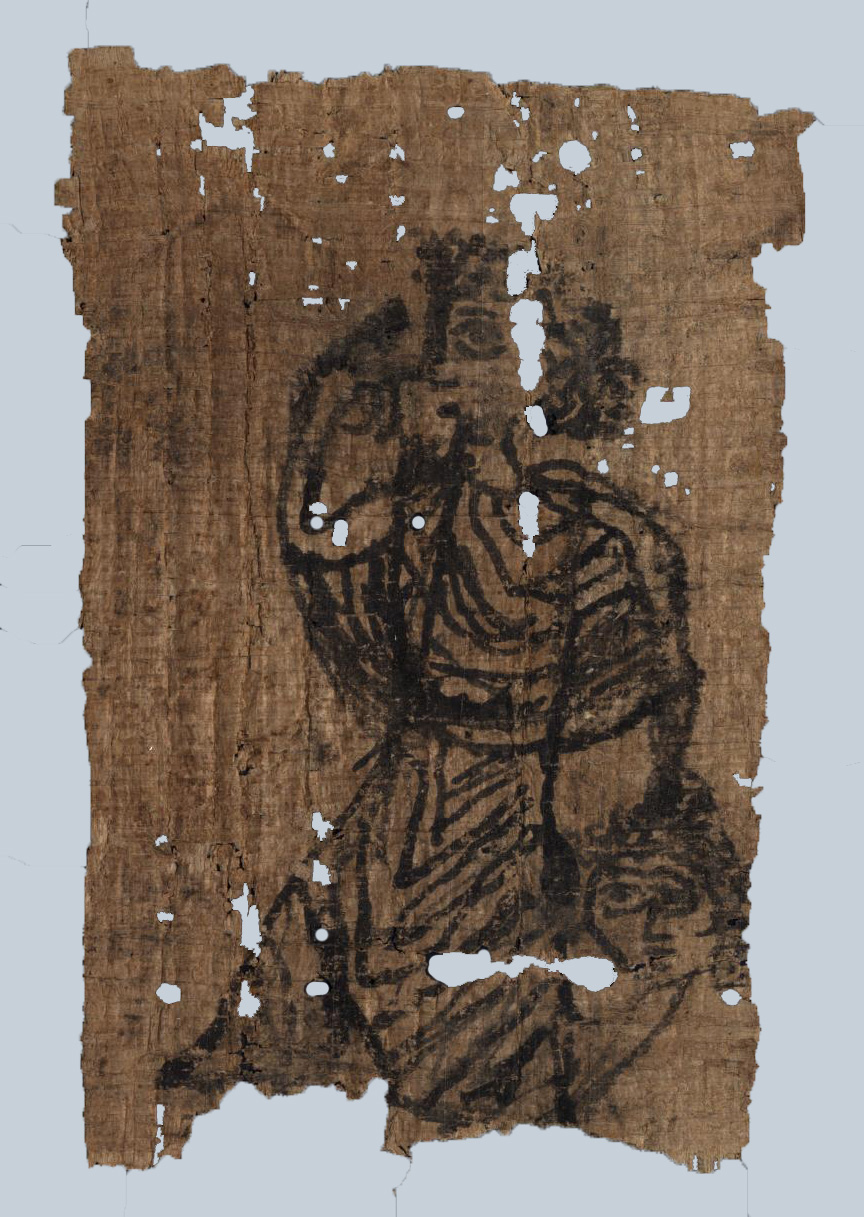
Papyrus, 9.3 x 6.2 cm, with a picture oriented along the fibers [--] and the reverse side [||] completely blank. It is probably a fragment from an illustrated papyrus roll, less likely from a codex page, with crude but vigorous brushwork depicting a maenad holding a severed male head by the hair in her left hand and her right arm raised in front of her forehead [Agave and the head of Pentheus, episode from The Bacchae of Euripides, 1139ff].
Close Description (adapted from Ann Kuttner's proposed draft, 29 March 2009): With the fragment oriented such that the (damaged) bottom margin would have been at the feet of the main figure, and the papyrus fibers running horizontally, the fragment appears to be cropped with a bit of care on the left and perhaps on the right (with some damage to the lower right) as vertical sides, with a slightly canted upper edge to the rough rectangle and a much more roughly edged lower area, cutting across the ankles of the depicted woman so that her feet are not visible. Both irregular and regular (circular) small holes and worn patches mar the papyrus, espoecially in the head and knee areas of the depicted woman. Because of assumed damage at the top, and serious damage at the bottom, it is not possible to determine how tall the original scroll (or page) may have been, and where in its open field(s) the illustration may have been placed. No evidence of associated text is visible. Such figures are known to occur on blank segments at the (beginnings and ?) ends of works or between text columns, or sometimes above or below the columns. [Get height of known scrolls of Euripides.] The reverse side of the fragment is completely blank, and the mostly vertical damage pattern is consistent with the scroll being rolled up in the usual horizontal fashion.
The artist used a thick brush stroke, with lines not much varying in thickness. The drawing illustrates the Bacchae of Euirpides: If we had text we could compare skill in drawing vs. skill in calligraphy; but as a literary scroll is likely to have been penned carefully, this sketch was perhaps added as an owner's or book-stall's afterthought.Image (Ann Kuttner): The fragment is trimmed, thus, around the figure of a slender draped and mantled woman shown in three-quarter view with her head in profile (though her enlarged eye is drawn as if full-face), striding to the left (her right), both arms and both legs spread wide and bent stharply at their joints. Her hair is bound back in a tight chignon; the pen strokes emphasize its wavy texture. An irregular tear above the presumed lower margin has erased the lower legs. She wears a short knee-length chiton, its strongly marked hem pulled tight by her kicking advance. We can still see the upper edge of her bare right shin bent in from of the knee, and one little cut-off stroke at the right still marks the bare inner thigh of her left leg.. From her bent and lowered right arm dangles a head she clutches by its long, loose, curling hair, shown nearly full face with enormous eyes, strongly marked brows, and mouth agape. Her right hand is swung up to her brow, pulling up the end of the mantle that is swathed across her upper body. The way in which she glances back to her left as she rushes forward indicates that she is running, even dancing, in agitation. The crude rendering of closely packed drapery folds emphasizes this motion,with its fabric pooling between her legs and pulling away from her lifted right thigh, the mantling drapery pulled up to free her capering motion. The clumsy but vigorous rendition attractively botches refined Greco-Roman sculptural, relief-carved, and pictorial drapery treatments.
Identification -- Image and Associated Text (Kuttner & Kraft): This short garment signals a mythological female figure; a short skirt is attribute only of Amazon or maenad or kalathiskos dancer. Clearly, it's not the barebreasted, armed woman warriorr, not the basket-dancer with headdress -- and the dangling human head told any ancient viewer the literary, Dionysiac subject, whose composition was unparalleled in any other story. Any maenad could be shown with the parts of wild animals torn apart in ritual ectasy, but here it must be Agave brandishing the severed head of her son Pentheus whom she and her sisters have torn apart, maddened by Dionysos into believing him a lion. [See, e.g. this depiction dated c 480 bce, Attic red figure kylix attributed to Douris -- or less gory, this one, also Attic dated c 450 bce, thus both probably older than Euripides' play]. This represents the murderous episode whose aftermath is near the end of Euripides' Bacchae, when Agave, still entranced, runs onto the stage down from Mount Kithairon, whirling her "lion's head" trophy and shouting to her father. Although the available text of The Bacchae 139ff states that the head was affixed to the end of Agave's thyrsus, we are told that while "Agave with the head of Pentheus is a not unfrequent subject in works of ancient art; she is generally represented as grasping it by the hair, instead of holding it aloft transfixed on the point of her thyrsus as in the present passage" (John Edwin Sandys, The Bacchae of Euripides: Critical and Explanatory Notes and with Numerout Illustrations from Works of Ancient Art [London: Clay 1900\4/] ad loc.). Sandys refers to several examples, none of which we have yet seen. Here are a few of his most relevant descriptions:
(15) In the Uffizi at Florence (Diitschke, die Antiken Marmorbildwerken der Uffizien in Florens, 1878, no. 503), in the middle of the right-hand recess of the hall of inscriptions stands a Roman cippus of white marble, on each of the four sides of which is a Bacchante in wild transport, one of whom has the thyrsus while two others are clashing cymbals. The one in front is draped in a long semi-transparent chiton her arms are stretched out wide, with a light shawl passing from one to the other and falling loosely between them ; her face looks upwards with an earnest gaze, and the hair is thrown back . . . ; in her right she holds a short sword with the point upwards, in her left a youthful head of finely chiselled profile, cut off just below the neck.
(16) In Cavaceppi's Raccolta I 50, there is an engraving of an Ibis on a pedestal with its base ornamented with winged figures at the comers and floral scrolls between. On the front of the pedestal is a relief representing a female figure dressed in a short chiton and a light shawl, standing on tip-toe in an attitude of dancing. On her head is a crown indicated by three spikes radiating upwards to the left, while she looks in profile to the right. In her right she holds a short sword with the point upwards; in her left, she is grasping by the top of the hair a human head which she is holding over the flames of an altar.
(17) On one of the three sides of the pedestal of a candelabrum in the British Museum, we have a relief representing Agave in a wild attitude with head thrown slightly back, and hair dishevelled, holding a human head in one hand, and a sword, with the point upwards, in the other.
It is more than legitimate to postulate that the drawing was sketched for a papyrus copy of that play. The relatively rare subject is highly unlikely to have been doodled on scrap of the artiist's own whim. Perhaps the sheet actually showed the aghast old man Kreon to whom Agave is running, for Greco-Roman artists tended to show both protagonists in the pregnant conversations, comic or tragic, of conventional drama and its visual expession. Frequently, as here, figures were drawn in real action, as it were, not in their dramatic masks. Euripides is well represented in the Mertens-Pack\3 online catalog of papyri and related materials from Egypt (170 items), although only 8 identified fragments of The Bacchae are included, none of which are illustrated. Mertens-Pack\3 also index 22 fragments with images, few of which have any clear association with identified texts (an interesting exception is PMonac 2.44 with a sketch of the abduction of Briseis from Homer, Iliad 1.345, but without any text). In codices and scrolls such illustrations often or always mark scene breaks; see K. Weitzmann, Illustrations in Roll and Codex (Princeton 1970).
Here is the revised brief narrative description of this piece in the Library
Oracle
database. Please offer corrections and further revisions as appropriate. I [RAK] wrongly had convinced myself that it must be Perseus and Medusa, but Ann Kuttner's identification is much more convincing.
Here is the image, extracted from the University Library scans:

The ducklike head(s) will reappear in a vellum Coptic amulet (below, 3.2 [E 16396], and perhaps also3.4 [E 16391]?). The vase-like outline with two sets of eyes and a pair of ears might have a couple of Greek/Coptic letters to its lower left (WR?) and perhaps some "magical" and/or Arabic characters as well.

Leather. Approximately 20 cm in diameter.
(Kuttner, 29mr2009) That painted leather of fruit and flasks hovering over a green basket ot tongue-patterned bowl, flanked it looks like by lobby uraeus disks, have to check the odd green-legged; objets behind -- cut as amulet?! costume patch?! from a proper leather page? super cool. Book of Dead it looks like. I don't know leather remains from the burials. The vessels are painted to show they are decorated themselves with relief surfaced even painting. Love the pallette. Someday can match a bit, I am sure that chaky sea-green would turn up.
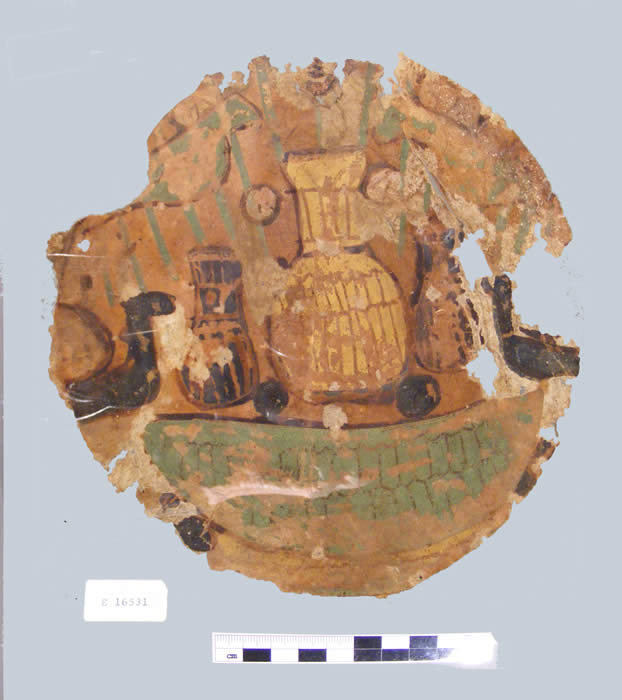
(Kuttner, 29mr2009) That horse with plumed headstall is neat: Pharonic-era composition, for chariots eg, tht we could expect to recur in Ptolemaic times? I don't know about Roman.
(Kuttner, 29mr2009) That owl is a model of Ptolemaic era for sure -- there are wonderful, careful relief ones for sculptors. Such things, we call `models.'
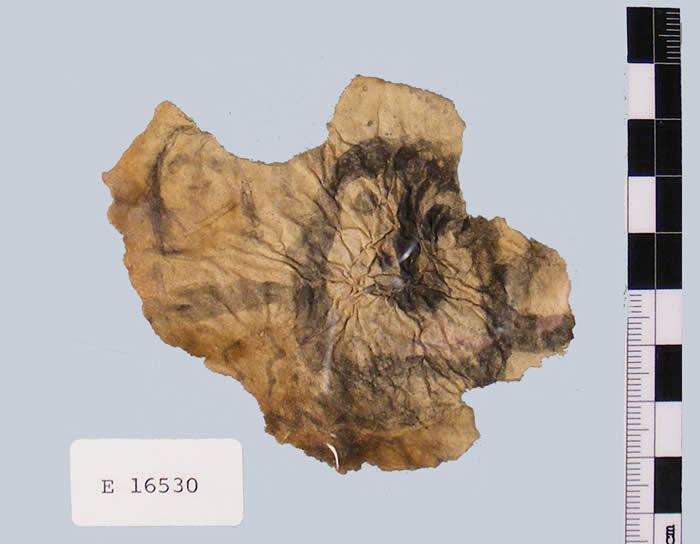
(Kuttner, 29mr2009) The jargon is, symplegma! in a classic pose, penetrated person flat [on couch], man standing to enter, her legs wrapped round him. I can tell you it is funky, if cartooning, sort of from inside, what is happeneing, and her pubic hair. Lots of comparanda in good art, not least in Egypt! Start Ptolemaic. Figurines esp. Also in Mediterranean -- wide circulation on vessels etc, as well as stauary. We think apotropaic, though this one could also just be enteraining porn.
A black and white picture of a limestone ostracon from Thebes dated c 1200 bce and "bearing the sketch of a Ba-bird" is published on page 9 of The Egyptian Mummy: Secrets and Science, by MASCA and the Egyptian Section of the University of Pennsylvania Museum (1980).
We have verified that these two fragments fit together, and I have
used PhotoShop here to recreate the original position (matching fiber patterns on front and back as well as the design). Note the presence of the
same whitish highlighting on both fragments. Other interesting
questions to investigate include the identification of the foliage
depicted, and what objects does the little person (man?) hold -- and what is the"hat"? Were there other similar figures in the lower portion? And, of
course, what could have been the function of such an item?
Here is my reconstructed image. The Museum card says "Figure clothed,
wears a hat. All done in brown ink, with white highlights." What
other information should go into the description for the revised Oracle data
base?
Ann Kuttner draws our attention to the publication of similar material:
The second one is a template for a Coptic textile, 2nd-6th c. CE, kind of production. . . . We now have in fact a much better drawn -- a truly fab -- papyrus of just this kind, and good overview work: Annemarie STAUFFER, Antike Musterblätter: Wirkkartons aus dem spätantiken und frühbyzantinischen Ägypten (2008) following up on her essay, "Cartoons for Weavers from Greaeco-Roman Egypt," Journal of Roman Archaeology Suppl. 19 (1993) 224-230.
The image on the left (from Turin) of this project page does indeed resemble our piece very closely. Also, note the white highlighting used in the similar first image here.
(Kuttner, 29mr2009)
It is a nude figure in fact, hair back, spotted -- a snood? with a drapery slung over extended arm, holding up small shield or tympanon -- a Dionysiac (?) female dancer, or a fighting Cupid, well known on Coptic textiles. The pattern is what we call `inhabited scroll,' figures tucked in vegetal interstices; you can see it was for a registred border, framng the central flowing vegetation above [where its marked edge below survives] and below [lost].
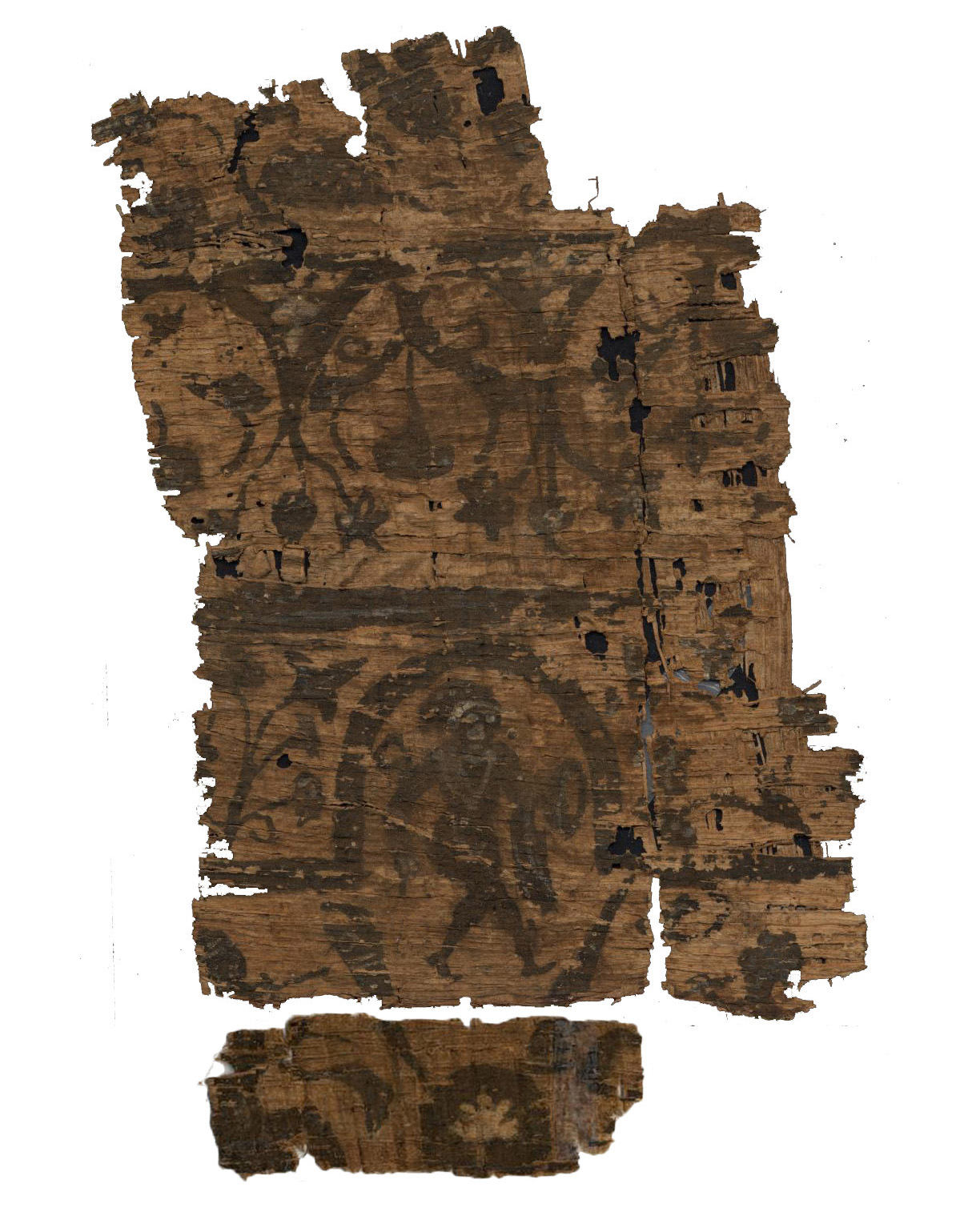
(Kuttner, 29mr2009) The leather knotted interlaces can be for a border, or large applique patch for the costume. Observe how the motif now at left turns the corner. With measurements I could tell you [about 5.4 x 12 cm]

For "magical" papyri, the most comprehensive resource is Karl Preisendanz, Papyri Graecae Magicae: Die Griechischen Zauberpapyri, of which two volumes appeared (1928, 1931 [1974\2 ed A. Henrichs) and the third, with extensive indices, was in galley proofs when the leaded plates fell victim to the Nazi war effort in 1941. Fortunately, photographs of PGM 3 survived and circulated among interested scholars for decades; much of the PGM material later was made available in English edited by Hans Dieter Betz, The Greek Magical Papyri in Translation, Including the Demotic Spells, Volume One: Texts (University of Chicago Press 1986, 1992\2)
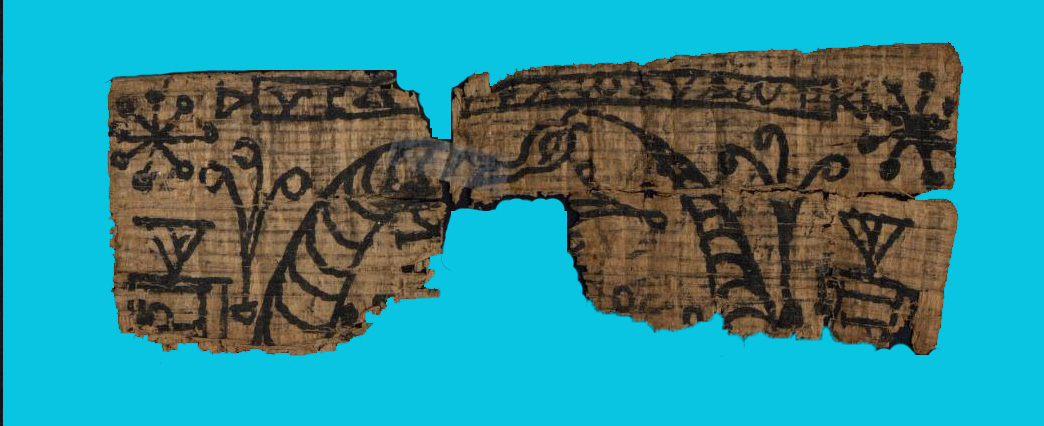
As a PS to this discussion, Ann Kuttner draws our attention to a papyrus formerly in Cairo but apparently now in Alexandria (and misidentified as "Coptic" on one web site) in which a crude picture of two men is found, either fighting (so Preisendanz, # 66) or perhaps joining in opposition to a third person (so R. W. Daniel). It is worth a look for its crude penmanship as well, and for questions of "magical" formulae at use in "Christian" contexts as suggested by Daniel's note. My translation of the adjuration, following Daniel's suggestions, is "I adjure you (plural) in accord with the great names:
cast out Philoxenos the cantor into contention with Gennadios his friend (or associate); cast Pelagios the presbyter into contention with Piloxenos the cantor." Daniel dates the piece anywhere between 4th and 6th century, and seems to favor a monastic setting.
Here is an enhanced image of the entire piece. On the left half, is a snowman-like body and a duck head facing left; opposite it on the right is a human head on a body made up of two boxes, and feet below. Some of the writing can be deciphered easily.
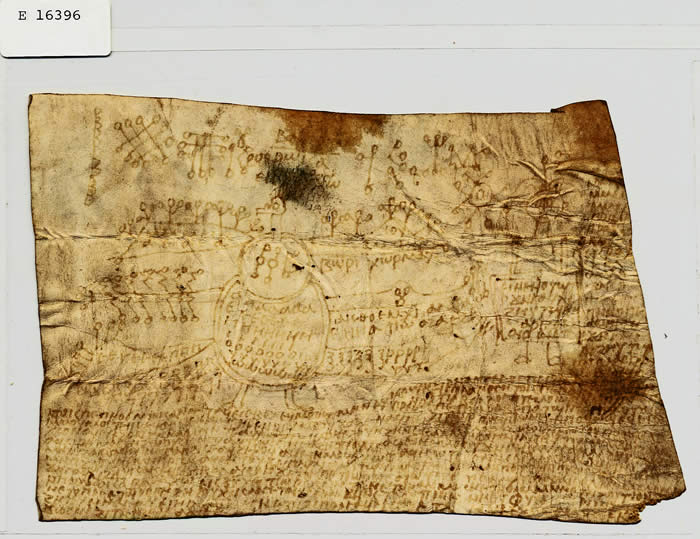
(Kuttner, 29mr2009) E 16392 is also a sex scene, a symplegma!
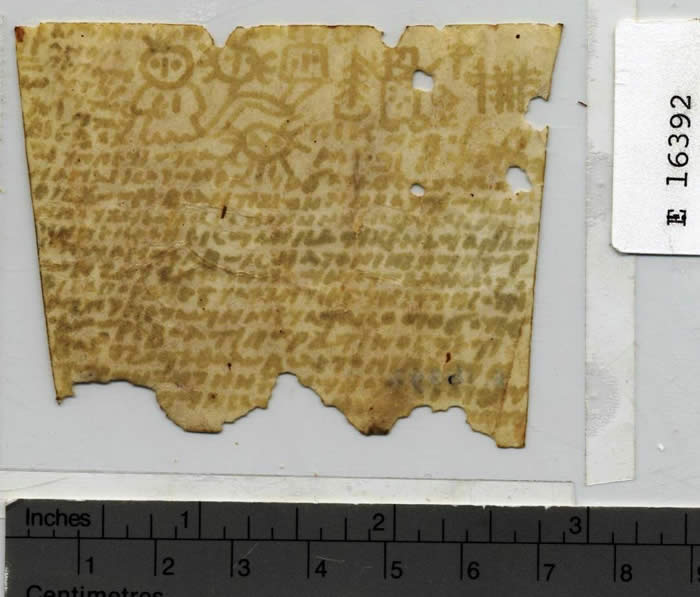
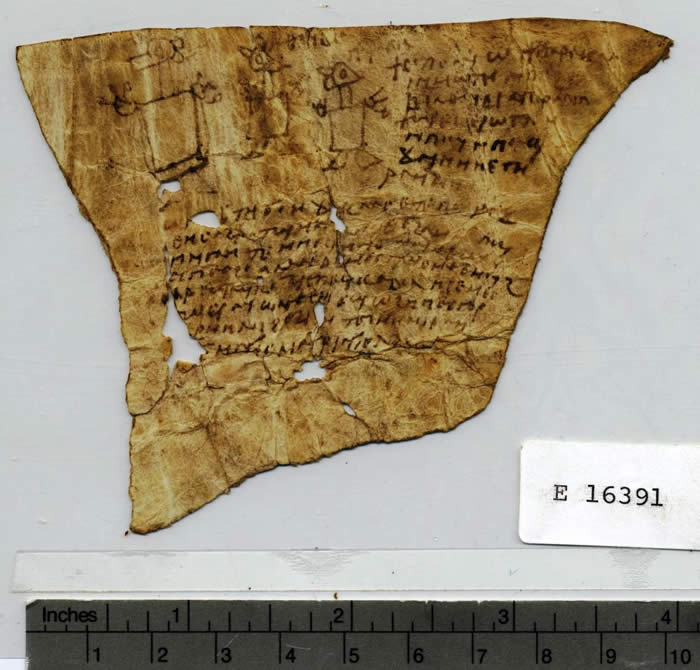
The back is blank, and shows a pattern of amuletic folding. Very little is discernable on the front.
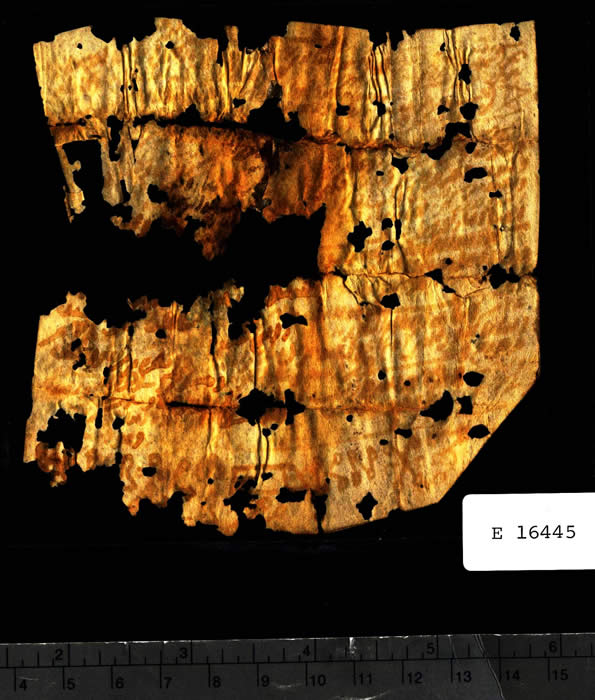
Here is an enhanced view of the top of the page, showing only the images without the Arabic text below. There is a single line of writing on the back, which is otherwise blank (thus not from a codex?).
The Arabic text refers to Patriarchs from Jewish scriptures and to early Christian persons. It is discussed by Giorgio DellaVida in his catalogue of Arabic materials from the University of Pennsylvania Museum (ca 1950; published posthumously 1981)

There seem to be four scenes:
(1) At the top left, I see a figure with an unusual head piece descending some stairs and handing a rod to another figure who is holding some sort of long interwoven item; could it be Moses and Aaron? Or perhaps the High Priest presenting the rod to Joseph (by which Joseph becomes protector of Mary)?
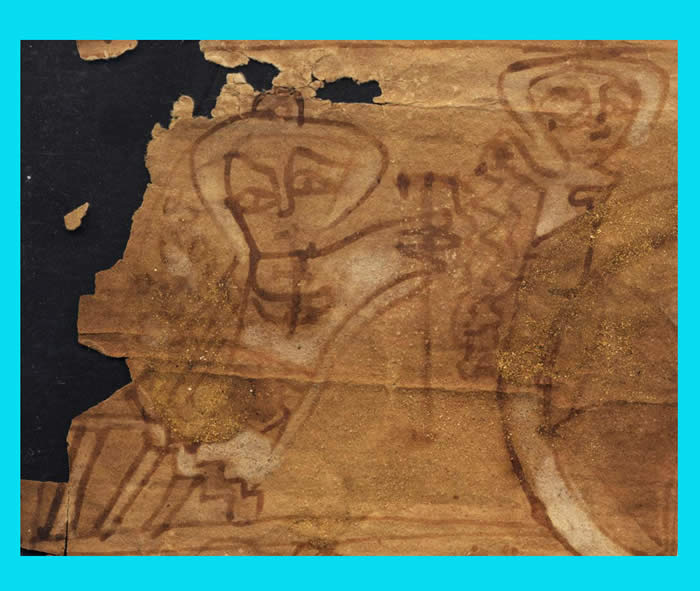
(2) At top right, two heads appear, but the bodies are lost.

(3) To the lower right, perhaps Abraham and the non-sacrifice of Isaac, with the very stylized ram facing the bush and perhaps the divine hand telling Abraham not to harm Isaac, who may be lying on an alter (but why so far away from Abraham? and what is between them?).
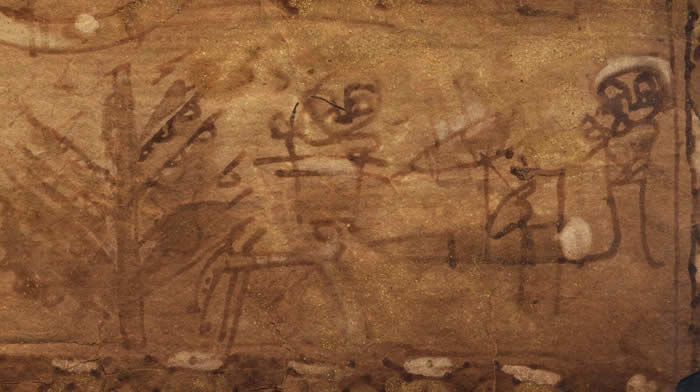
(4) At the lower left, a very nice fruited tree (or is it a person, beset by insects?!) can be seen, but not much else to the left (perhaps a column, and clouds or mountains).
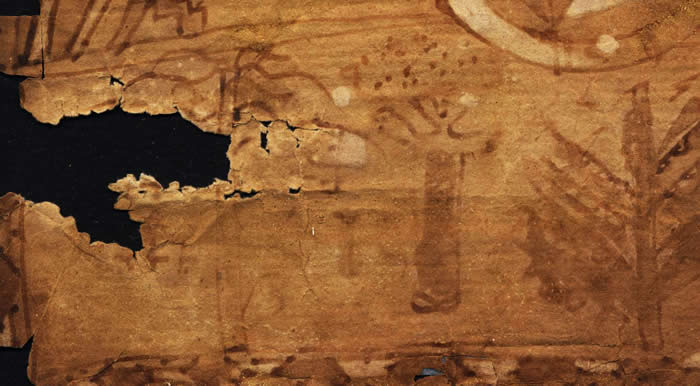
Something like a bird (an owl?) also appears above the large circular central design, and the decorated border is quite attractive.
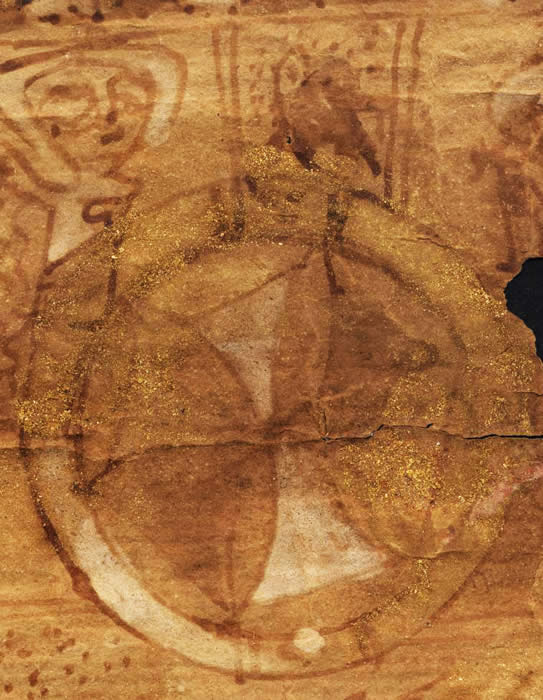

Discussed by DellaVida #18 (on paper, upper part of a land-tax receipt)
Papyrus. 15.2 x 14 cm. I have no idea what this represents. It does not seem to be large lettering. In one position, the holes make it appear to be a mask (eyes, mouth), but that is almost certainly coincidence, unless perhaps it is an owl image such as the "owl" like vellum image (E 16530) that is shown above with the owl ostracon (1.4.2):
(Kuttner, 29mr2009) (E 16503) `Mask': those holes in eyes and nostrils/mouth are deliberate! not a bug, a human, highly stylized, in format that comes from Late Antique, Coptic and post-conquest Icons. [[But it seems too small for a real mask, and the holes are consistent with horizontal folds for which the blank back provides further evidence.]]
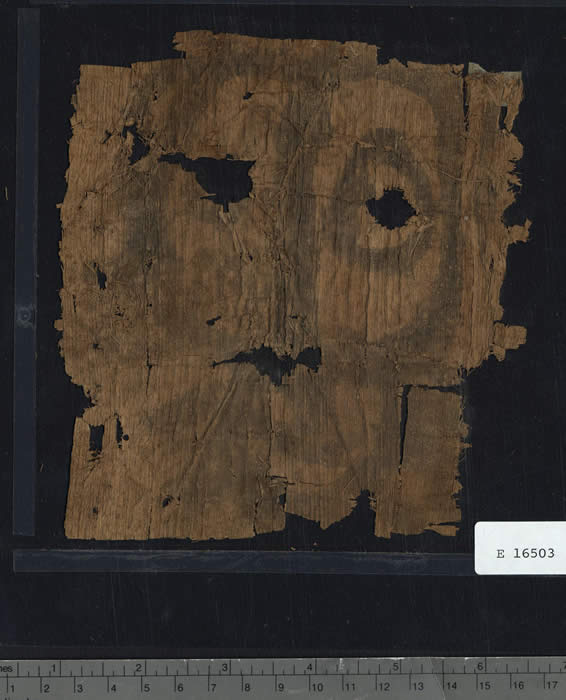
Here is a much manipulated version of E16503 (attempting to emphasize the ink patterns) with the fibers horizontal. The back appears to be completely blank. What do you think? Part of a beetle? If I put the shortest side up (the side to the left here), I can see a pineapple shape! Or some other sort of plant.

E 16724A HIERATIC document (Ptolemaic amulet)
E 16724B HIERATIC document (Ptolemaic amulet)
E 16724C HIERATIC document (Ptolemaic amulet)
E 16724D HIERATIC document (Ptolemaic amulet)
29-086-0502 HIEROGLYPHIC (with image; other side)
E 16222 a+b cartonnage images (vivid paint colors, cloth base over hard surface)
E 16223 cartonnage images A-E (similar to 16222)
E 16224 cartonnage (similar to 16222)
E 16225 cartonnage (similar to 16222)
E16226 cartonnage (similar to 16222, shape of lower leg with foot)
E 16451 designs and/or large writing (panel 1, panel 2 [normal writing as well], panel 3)
These are some of the interesting non linguistic aspects of papyrology, perhaps adding another "fun" element to the topic! Your ideas are solicited, and your possible interest in filling out the research on these items.
//pause; 01ap2009//